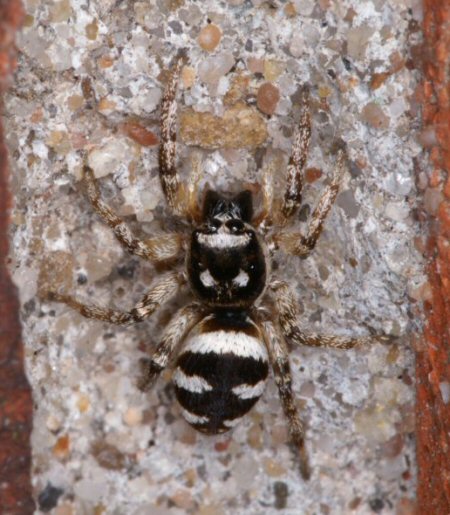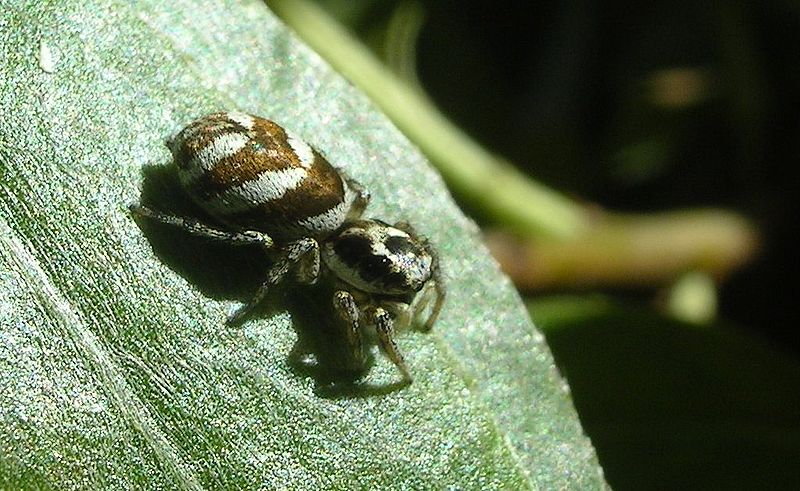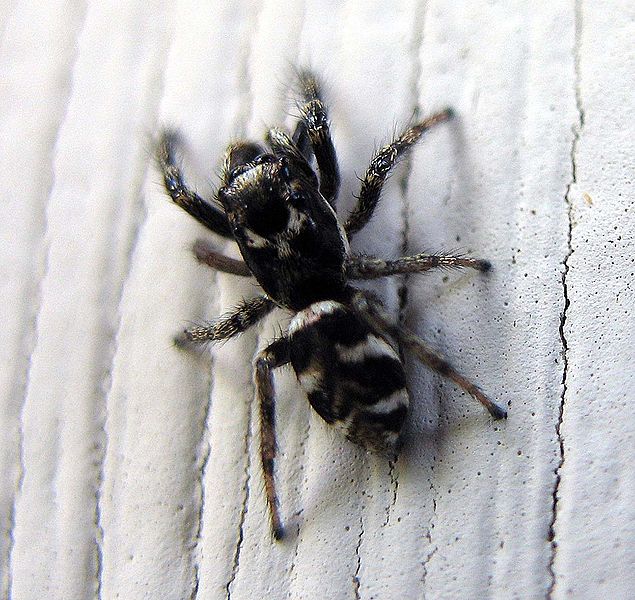Classification
 "So
where do zebra spiders fit in?"
"So
where do zebra spiders fit in?"
Domain: Eukarya
Kingdom: Animalia
Phylum: Arthropoda
Class:
Arachnida
Order: Araneae
Family: Salticidae
Genus: Salticus
Species: Salticus scenicus
"What characteristics make Salticus scenicus part of
each of these taxonomic levels?"
Domain: Eukarya- All members possess a true nucleus and membrane-bound organelles.
Kingdom:
Animalia- All members are multicellular heterotrophs
without cell walls. Also, locomotion is a distinct
characteristic among these members.
Genus:
Salticus- Was used as a salticid
dump for a long time, and many species originally described in
Salticus have been transferred elsewhere.
They are typically marked with a black and white
pattern, with some featuring transverse stripes. Mature males have very long
chelicerae on which they rest their
long, thin pedipalps. Females are from 3.5 to 7 mm
in length, with males reaching up to 5 mm.

Phylum: Arthropoda- The zebra spider shares
their classification as arthropods with other joint-legged
creatures such as lobsters, millipedes, scorpions, and insects.
All of these members are triploblastic, contain a coelomate,
have a true digestive system, bilateral symmetry,
segmented bodies.
Class: Arachnida- The zebra spider, along with
all other eight-legged species within the phylum Arthropoda, live in terrestrial areas. A key diagnostic feature of
this class is the absence of antennae and wings exhibited by its
members.
Order:
Araneae-The zebra spider, along with all
spiders with in the class Arachnida, belong in the order Araneae.
Key features include: two body segments, eight legs, no
chewing mouth parts, capable of producing silk.
 Family: Salticidae- The zebra spider fits into
the family Salticidae with over 4000 other species of jumping
spiders. Their most obvious feature, apart from their jumping
ability, is their large front-eyes which are clearly visible
even with the naked eye. Most Jumping spiders do not build a
web, they use their four pairs of large eyes to
locate prey and their jumping ability to pounce and
capture prey. Also, this family of spiders are relatively
small in size.
Family: Salticidae- The zebra spider fits into
the family Salticidae with over 4000 other species of jumping
spiders. Their most obvious feature, apart from their jumping
ability, is their large front-eyes which are clearly visible
even with the naked eye. Most Jumping spiders do not build a
web, they use their four pairs of large eyes to
locate prey and their jumping ability to pounce and
capture prey. Also, this family of spiders are relatively
small in size. Species: Salticus scenicus - Is the most
common of the species found in the Genus Salticus. Their
size ranges between 5 -7 mm and they have a remarkable white and
black stripe pattern, giving them the common name zebra spider. A
key difference in these species is that they can be found on sunny
walls. Like other jumping spiders, the zebra spider does not build a
web. They use their four pairs of large eyes to locate prey and
their jumping ability to pounce and
capture prey. The scientific name Salticus scenicus
comes from Latin roots, meaning "dancing" "on the
stage"
in English.
Species: Salticus scenicus - Is the most
common of the species found in the Genus Salticus. Their
size ranges between 5 -7 mm and they have a remarkable white and
black stripe pattern, giving them the common name zebra spider. A
key difference in these species is that they can be found on sunny
walls. Like other jumping spiders, the zebra spider does not build a
web. They use their four pairs of large eyes to locate prey and
their jumping ability to pounce and
capture prey. The scientific name Salticus scenicus
comes from Latin roots, meaning "dancing" "on the
stage"
in English.
Now that you know why they are in each level, take a
look at their
phylogenetic trees
to help get a good visual.